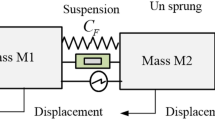Abstract
The present study has focused on the comparison of MR damper dynamic models for the purpose of hardware in the loop simulation. A vehicle dynamic model for large-sized bus and a control logic for MR damper was built. Two typical MR damper models, viz. Bouc-Wen and hyperbolic tangent model have been considered in this study and the advantages and disadvantages of each model on the aspect of HILS system is discussed. We discussed the limitations of each model based on the analysis of the vehicle dynamic simulation. The results showed that the existing models are not suitable for HILS system. We proposed the modified hyperbolic tangent model by adopting low-pass filters. The results from the simulation showed the advantages of the modified model which were validated through HILS system.
Similar content being viewed by others
Abbreviations
- F :
-
damping force
- x :
-
damper stroke displacement
- α b :
-
hysteresis coefficient of Bouc-wen model
- z :
-
hysteresis displacement
- β b, γ b, n, A :
-
parameter of hysteresis shape of Bouc-wen model
- a 1, a 2, p :
-
parameter of damping coefficient function
- k :
-
stiffness
- m :
-
mass
- F 0 :
-
measurement bias of damping force
- α h :
-
hysteresis coefficient of Hyperbolic tangent model
- β h, γ h :
-
parameter of hysteresis shape of Hyperbolic tangent model
- c :
-
damping coefficient
- T :
-
time step size
References
Dahl, P. R. (1976). Solid friction damping of mechanical vibrations. AIAA 14, 12, 1675–1682.
de Wit, C. C., Olsson, H., Astrom, K. J. and Lischinsky, P. (1995). A new model for control of systems with friction. IEEE Trans. Automatic Control 40, 3, 419–425
Hu, G., Liu, Q., Ding, R. and Li, G. (2017). Vibration control of semi-active suspension system with magnetorheological damper based on hyperbolic tangent model. Advances in Mechanical Engineering 9, 5, 1–15
Jeon, H. J. and Jung, S. (2010). Vehicle suspension control using an MR damper of a Bouc-Wen model obtained from experimental studies. J. Institute of Control, Robotics and Systems 16, 2, 151–157
Kang, T. H. and Baek, W. K. (2002). Ride analysis of a semi-active suspension seat with sky-hook control. The Korea Society for Power System Engineering 6, 2, 33–39
Kasprzyk, J., Wyrwal, J. and Krauz, P. (2014). Automotive MR damper modelling for semi-active vibration control. Proc. IEEE/ASME Int. Conf. Advanced Intelligent Mechatronics (AIM), Besacon, France.
Kwok, N. M., Ha, Q. P. and Nguyen, T. H. (2006). A novel hysteretic model for magnetorheological fluid dampers and parameter identification using particle swarm optimization. Sensors and Actuators A: Physical 132, 2, 441–451
Kim, H. Y., Lee, D. C., Rhee, E. J., Koak, K. Y. and Kang, G. G. (2017). A study on an MR damper HILS system for a bus. J. Institute of Control, Robotics and Systems 23, 2, 109–116
Lee, J. W., Lee, J. S. and Beak, W. K. (2006). Performance improvement of A suspension-seat controller using HILS. Proc. KSME Autumn Annual Meeting, 739–744
Na, U. J. (2013). Control of damping coefficients for the shear mode MR dampers using inverse model. Trans. Korean Society for Noise and Vibration Engineering 23, 5, 445–455
Reichert, B. A. (1997). Application of magnetorheological dampers for vehicle seat. Proc. IEEE/ASME Int. Conf. Advanced Intelligent Mechatronics (AIM).
Sahin, I., Engin, T. and Cesmeci, S. (2010). Comparison of some existing parametric models for magnetorheological fluid dampers. Smart Materials and Structures 19, 3, 1–11
Wang, D. H. and Liao, W. H. (2011). Magnetorheological fluid dampers: A review of parametric modeling. Smart Materials and Structure 20, 2, 1–34
Wen, Y. K. (1976). Method of random vibration of hysteretic systems. J. Engineering Mechanics Division 102, 2, 249–263
Wereley, N. M., Pang, L. and Kamath, G. M. (1988). Idealized hysteresis modeling of electrorheological and magnetorheological dampers. J. Intelligent Material Systems and Structures 9, 8, 642–649
Yang, G. (2001). Large-scale Magnetorheological Fluid Damper for Vibration Mitigation: Modeling, Testing and Control. Ph. D. Dissertation. University of Notre Dame. Notre Dame, Indiana, USA.
Yoon, H. S., Moon, I. D., Kim, J. W., Oh, C. Y. and Lee, H. W. (2012). Semi-active control of a suspension system with a MR damper of a large-sized bus. J. Korean Society of Manufacturing Technology Engineers 21, 4, 683–690
Youn, I., Khan, M. A., Uddin, N., Youn, E. and Tomizuka, M. (2017). Road disturbance estimation for the optimal preview control of an active suspension systems based on tracked vehicle model. Int. J. Automotive Technology 18, 2, 307–316
Author information
Authors and Affiliations
Corresponding author
Rights and permissions
About this article
Cite this article
Jeon, S., Kim, J., Jin, S.W. et al. Comparison of Dynamic Models of Mr Damper for Hardware in the Loop Simulation of Large-Sized Buses. Int.J Automot. Technol. 19, 677–685 (2018). https://doi.org/10.1007/s12239-018-0065-5
Received:
Revised:
Accepted:
Published:
Issue Date:
DOI: https://doi.org/10.1007/s12239-018-0065-5




